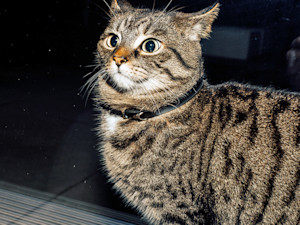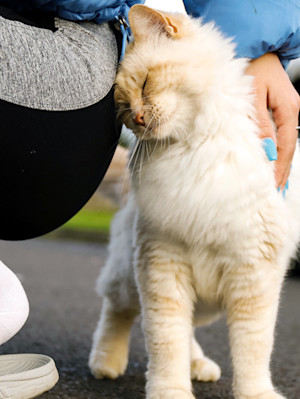Why Can’t Your Cat Handle Closed Doors?
Knock knock, it’s me, your cat. Again.

Share Article
It’s an all-too-familiar scene: you close the bathroom door for a moment’s privacy, only to be met with desperate paws reaching under the gap, accompanied by persistent meowing and scratching. Your feline friend seems personally offended, determined to regain access by any means necessary.
But what drives this feline quirk? Is it simple curiosity, territorial anxiety, or something deeper rooted in their evolutionary psychology?
Territory and control: your cat’s home security system
“Cats are territorial animals, so it’s in their nature to want to access all parts of their environment,” explains Sammie Ravenscroft, regional community behaviourist for Cats Protection. “A closed door may not bother some cats, particularly if it’s an area they don’t usually have access to or if it’s for a short period. However, if they are prevented from accessing an area that they usually can, they may become frustrated.”
This territorial need goes beyond simple access – it’s about maintaining their claimed space through scent marking.
“As territorial animals, a cat’s environment is incredibly important to them, and they reinforce their ‘ownership’ of that territory through scent marking,” Ravenscroft continues. “If they’re unable to keep their territory ‘topped up’ with their scent, they may become anxious and stressed, especially if there are other animals in the household which they may feel threatened by.”
Survival instincts: the hunter and the hunted
There’s an evolutionary component to this behaviour that dates back to their wild ancestors.
“In evolutionary terms cats are both predators and, to some extent, prey,” explains Dr Primrose Mossopens in new tab. “While they can be pretty fierce, they’re very aware that they’re vulnerable to larger animals attacking them. This means they’ve evolved to seek control over their situation and have the ability to flee if they need to.”
This survival instinct manifests in their need for escape routes and access to safe spaces – something a closed door directly impedes.
“It’s one of the reasons a lot of cats don’t enjoy being held for reassurance when scared – they need to have control over their ability to run away. Closing off an area that they usually have access to can limit this.”
The power of feline curiosity
The saying ‘curiosity killed the cat’ exists for good reason. Cats have a natural investigative drive that makes closed doors particularly vexing.
“Cats are naturally curious creatures, and a closed door presents a barrier to their exploration,” says Axel Lagercrantz, CEO of Pets4Homesopens in new tab. “They might think there’s something exciting or interesting on the other side, and their instincts push them to investigate.”
This curiosity isn’t random – it’s linked to their hunting instincts. “Cats are hardwired to track and chase, so a closed door might feel like a challenge they need to conquer,” explains Lagercrantz .
How to spot ‘door distress’
Cats communicate their frustration with closed doors in various ways. “It will vary from cat to cat,” notes Ravenscroft. “Some may scratch at the door, either in an attempt to open it or to gain your attention. Others may vocalise loudly, again to attract attention, while others may get more creative, perhaps jumping up onto the handle to force it open.”
Temporary curiosity, however, typically resolves quickly. “If it’s momentary curiosity, most cats will become bored after a short time or will be easily distracted by play or fuss,” explains Dr Moss.
Managing your cat’s door dilemma
How should you respond when your cat starts protesting against a closed door? “It’s important that you first check your cat has access to all their basic needs – food, water, litter tray and hiding spaces where they can sleep and rest,” advises Ravenscroft.
For temporary restrictions, distraction can be effective. “If your cat is being temporarily kept out of a certain area, perhaps because of building work, then you can try and distract them with a fuss or a play,” Ravenscroft suggests. “If they are getting particularly stressed, you could look at using a pheromone plug-in or consult a behaviourist.”
Lagercrantz offers a word of warning: “If your cat is persistent, opening the door might seem like the easiest solution – but doing so regularly could reinforce the behaviour.“
When to be concerned
While door frustration is normal, extreme reactions might indicate deeper issues.
“If your cat is regularly showing signs of intense frustration and you’re struggling to manage this, it’s worth speaking to your veterinarian,” advises Dr Moss. “They can assess your cat and the situation and if needed help you find an appropriate behaviourist.”
Look out for more serious stress indicators. “If your cat starts showing signs of stress – like urinating or soiling inappropriately, becoming withdrawn or showing defensive behaviour, you should contact your vet for advice and seek advice from a qualified and accredited behaviourist. These can be found from the Animal Behaviour and Training Councilopens in new tab,” Ravenscroft adds.
Is closing doors on cats cruel?
Many cat owners worry they’re being unkind by restricting their pet’s movement – but experts agree that sometimes it’s necessary and appropriate.
“There are many situations where closing doors can help to keep cats safe, even if they protest,” explains Dr Moss. “Separating them from other pets to prevent aggression or anxiety, keeping them away from toxic substances or fresh paint, or even keeping them indoors if they’re an indoor only cat are all important reasons to keep doors closed.”
Ravenscroft adds: “A good example is when fireworks are being used outside, when it’s essential to keep your cat indoors. Other examples may include building work or if your cat is recovering from surgery and your vet says they need to have activity restricted.”
The reinforcement trap
One challenge many cat parents face is accidentally training their cats to demand access.
“Cats can definitely learn that certain behaviours will lead to them getting what they want – if you’re not careful, your cat can end up ‘training’ you!” warns Dr Moss. “It’s important not to encourage behaviours you can’t tolerate long-term. If your cat routinely begs at your bedroom door at 3am, it’s tempting to get up and let them in to get some more sleep. But when this becomes a habit every night, will you be able to tolerate it?”
If you plan to permanently restrict access to a certain area, work out why your cat is so keen to access that area and see if you can replicate that elsewhere, suggests Ravenscroft. “For instance, if you want to keep your cat out of your bedroom, it’s worth thinking about why it seems so appealing to them. Perhaps it’s a quiet area with plenty of hiding spaces – like under the bed – both of which your cat needs to feel safe. Think about how you can create this environment in another part of the home.”
Creating a door-friendly environment
Environmental enrichment can help cats cope better with occasional closed doors. “Ensure your cat has sufficient stimulation including regular playtime,” suggests Dr Moss. “Rotate out toys to prevent boredom and offer new objects like boxes or cat grass for your cat to engage with. Simply moving furniture can help to alleviate boredom!”
Lagercrantz recommends creating designated ‘cat zones’ throughout the home to give them a sense of ownership and security. “If you want to get them used to closed doors, try positive reinforcement – rewarding calm behaviour with treats or affection when a door is shut.“
Accepting feline nature
Understanding why cats react to closed doors helps us accommodate their natural behaviours while maintaining necessary boundaries.
As Lagercrantz puts it: “Most cats will act this way, especially if they have access to different areas of the house or there’s something intriguing behind the door. It’s just part of who they are – little explorers at heart.”
Living with cats means accepting their unique perspective on privacy and space – even if it means the occasional paw under the bathroom door.

Natalie Gil
Natalie Gil is a freelance journalist who has written for iNews, the Irish Independent, Stylist and more. She previously worked at Refinery29, Monzo and the Guardian, and is the proud cat mum of British Shorthairs Prune and Oat.
Related articles
![a picture of a startled tabby cat caught in a camera flash]()
FRAPs: The Reason Your Cat Goes Bonkers at 3am
It’s especially common after a poo
![a picture of a white fluffy cat rubbing their head against a human leg]()
Headbutts & Boops: Why Your Cat Is Bunting You
It’s (yet another) adorable behaviour your cat does, but could it indicate something more serious?
Why Is My Cat Obsessed With Bum Pats?
Turns out they back it up for a reason – here’s the science behind it
![Cat grabbing onto ledge of table and looking to the left]()
Is Your New Cat Stalking You?
Yes, they are right behind you
![cat staring at person on table]()
Why is My Cat Giving Me the Evil Eye?
...Is it something I said?
Why Does My Cat’s Tail Vibrate?
They’re trying to tell you something... but what?






